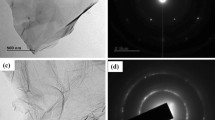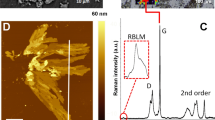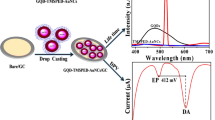Abstract
In this paper, a simple and efficient electrochemical sensor based on indium sulfide nanosheet arrays (In2S3 NSAs) grown on 3D graphene (3D Gr) has been developed. 3D Gr was obtained by chemical vapor deposition (CVD) and In2S3 NSAs were prepared by a hydrothermal method. The composite (In2S3 NSAs-3D Gr) has a large accommodation space to contact with biological molecules. The current generated by the redox reaction of epinephrine (EP) on the surface of the In2S3 NSAs-3D Gr becomes an important indicator of the sensor value. The sensitivity of the sensor for the detection of EP in the range of 0–60 µm is 2.46 µA µM− 1 with a detection limit of 0.12 µM (S/N = 3). Meanwhile, the novel sensor has a good stability and selectivity. It also has potential for real detection of EP in human serum.







Similar content being viewed by others
References
H.F. Brown, D. Difrancesco, S.J. Noble, How does adrenaline accelerate the heart? Nature 280(5719), 235–236 (1979)
P. Narchi, J.X. Mazoit, S. Cohen et al., Heart rate response to an I.V. Test dose of adrenaline and lignocaine with and without atropine pretreatment. Br. J. Anaesth. 66(5), 583–586 (1991)
M.C. Cruz, R.S. Carvalho, P.M. Daniel et al., A rash decision. The hazards of the wrongful use of adrenaline. Rom J Anaesth Intensive Care 24(2), 163–166 (2017)
J. Droste, N. Narayan, Anaphylaxis, Lack of hospital doctors' knowledge of adrenaline (epinephrine) administration in adults could endanger patients' safety. European Annals of Allergy & Clinical Immunology 44(3), 122–127 (2012)
G.A. Tığ, Development of electrochemical sensor for detection of ascorbic acid, dopamine, uric acid and l-tryptophan based on Ag nanoparticles and poly (l-arginine)-graphene oxide composite. J. Electroanal. Chem. 807(15), 19–28 (2017)
Z. Jing, Z. Yan, G. Man-Dong, An electrochemical sensor for determination of adrenaline based on AuNPs-LDHs film. Journal of Analytical Science 33(3), 357–361 (2017)
S.S. Shankar, R.M. Shereema, R.B. Rakhi, Electrochemical determination of adrenaline using MXene/Graphite composite paste electrodes. ACS Applied Materials Interfaces 10(50), 43343–43351 (2018)
G. Maduraiveeran, M. Sasidharan, V. Ganesan, Electrochemical sensor and biosensor platforms based on advanced nanomaterials for biological and biomedical applications. Biosens Bioelectron 103(30), 113–129 (2018)
M. Wang, L. Yan, W. Lei et al., A label-free fluorescence nanosensor for the determination of adrenaline based on graphene quantum dots. Anal. Methods 9(30), 4434–4438 (2017)
W. Hsin-Pin, C. Tian-Lu, T. Wei-Lung, Phosphate-modified TiO2 nanoparticles for selective detection of dopamine, levodopa, adrenaline, and catechol based on fluorescence quenching. Langmuir the Acs Journal of Surfaces & Colloids 23(14), 7880–7885 (2007)
A. Baran, L. Fox-Machado, Detection of adrenaline on poly(3-aminobenzylamine) ultrathin film by electrochemical-surface plasmon resonance spectroscopy. Langmuir Acs J. Surf. Colloids 26(23), 18476–18482 (2010)
KAMBAS, Near band-edge optical investigation of α-In2S3 and α-In2S3 – xsex mixed crystals. Physica B Condensed Matter 160(2), 103–107 (1989)
T. Sall, B.M. Soucase, M. Mollar et al., Chemical spray pyrolysis of β-In2S3 thin films deposited at different temperatures. J. Phys. Chem. Solids 76(76), 100–104 (2015)
E. Ghorbani, K. Albe, Intrinsic point defects in β-In2S3 studied by means of hybrid density-functional theory. J. Appl. Phys. 123(10), 103–107 (2018)
S. Wang, B.Y. Guan, Y. Lu et al., Formation of hierarchical In2S3-CdIn2S4 heterostructured nanotubes for efficient and stable visible light CO2 reduction. J. Am. Chem. Soc. 139(48), 17305–17308 (2017)
K. Jeehwan, H. Homare, T.K. Todorov et al., High efficiency Cu2ZnSn (S,Se) 4 solar cells by applying a double In2S3/CdS emitter. Cheminform 46(5), 7427–7431 (2015)
F. Yu, W. Zhao, S. Liu, A straightforward chemical approach for excellent In2S3 electron transport layer for high-efficiency perovskite solar cells. RSC Adv. 9(2), 884–890 (2019)
H. Cansizoglu, M.F. Cansizoglu, F. Watanabe et al., Enhanced photocurrent and dynamic response in vertically aligned In2S3/Ag core/shell nanorod array photoconductive devices. ACS Appl. Mater. Interfaces 6(11), 8673–8682 (2014)
H. Cansizoglu, M.F. Cansizoglu, T. Karabacak, Effect of shell coating techniques on dynamic response of photoconductive core/shell nanorod arrays. Adv. Mater. Interfaces 2(16), 1500275 (2016)
C. Wang, C. Mu, J. Xiang et al., Microwave synthesized In2S3@CNTs with excellent properties in lithium-ion battery and electromagnetic wave absorption. Chin. J. Chem. 36(2), 157–161 (2018)
W. Sheng, S. Ye, M. Dou et al., Constructing 1D hierarchical heterostructures of MoS2 /In2S3 nanosheets on CdS nanorod arrays for enhanced photoelectrocatalytic H2 evolution. Appl. Surf. Sci. 436(1), 613–623 (2018)
Z. Yanwu, M. Shanthi, C. Weiwei et al., Graphene and graphene oxide: synthesis, properties, and applications. Cheminform 22(35), 3906–3924 (2010)
F. Mori, M. Kubouchi, Y. Arao, Effect of graphite structures on the productivity and quality of few-layer graphene in liquid-phase exfoliation. J. Mater. Sci. 53(18), 12807–12815 (2018)
B.H. Min, D.W. Kim, K.H. Kim et al., Bulk scale growth of CVD graphene on Ni nanowire foams for a highly dense and elastic 3D conducting electrode. Carbon 80(1), 446–452 (2014)
H.Y. Yue, H. Zhang, S. Huang et al., Synthesis of ZnO nanowire arrays/3D graphene foam and application for determination of levodopa in the presence of uric acid. Biosens. Bioelectron. 89(15), 592–597 (2017)
L. Stobinski, B. Lesiak, A. Malolepszy et al., Graphene oxide and reduced graphene oxide studied by the XRD, TEM and electron spectroscopy methods. J. Electron Spectrosc. Relat. Phenom. 195(15), 145–154 (2014)
L. Hua, L. Ning, H. Zhang et al., A simple and convenient fluorescent strategy for the highly sensitive detection of dopamine and ascorbic acid based on graphene quantum dots. Talanta 189(1), 190–195 (2018)
D. Molinnus, G. Hardt, L. Käver et al., Chip-based biosensor for the detection of low adrenaline concentrations to support adrenal venous sampling. Sens. Actuators B Chem. 272(1), 21–27 (2018)
M.D. Tezerjani, A. Benvidi, A.D. Firouzabadi et al., Epinephrine electrochemical sensor based on a carbon paste electrode modified with hydroquinone derivative and graphene oxide nano-sheets: Simultaneous determination of epinephrine, acetaminophen and dopamine. Measurement 101(4), 183–189 (2017)
M.R. Akhgar, H. Beitollahi, M. Salari et al., Fabrication of a sensor for simultaneous determination of norepinephrine, acetaminophen and tryptophan using a modified carbon nanotube paste electrode. Anal. Methods 4(1), 259–264 (2012)
Acknowledgements
This work is supported by the fundamental research foundation for University of Heilongjiang province (LGYC2018JQ012) and the foundation for selected overseas Chinese Scholar, Ministry of personnel of Heilongjiang province (2018383).
Author information
Authors and Affiliations
Corresponding author
Additional information
Publisher's Note
Springer Nature remains neutral with regard to jurisdictional claims in published maps and institutional affiliations.
Electronic supplementary material
Below is the link to the electronic supplementary material.
Rights and permissions
About this article
Cite this article
Guo, X., Yue, H., Huang, S. et al. In2S3 nanosheet arrays grown on the 3D graphene for sensitive detection of epinephrine in the presence of uric acid. J Mater Sci: Mater Electron 31, 3549–3556 (2020). https://doi.org/10.1007/s10854-020-02903-z
Received:
Accepted:
Published:
Issue Date:
DOI: https://doi.org/10.1007/s10854-020-02903-z




